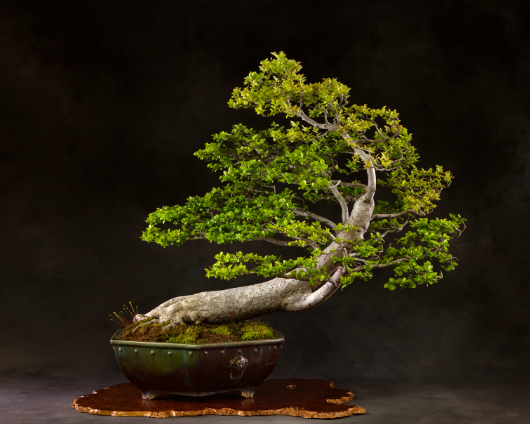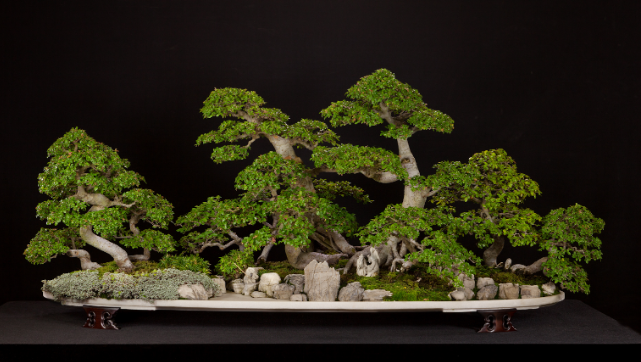The interesting pattern which gives Lacebark Elms their name.
The Chinese Elm, also known as Ulmus parvifolia or Lacebark Elm, is a deciduous tree species native to China, Korea and Japan. The name Lacebark Elm refers to the interesting pattern created as parts of the tree’s bark flake off with age. This elm is a very hardy species that can grow in moist or dry soils – these trees can survive in USDA Hardiness Zones 4 through 9 – and thrive in hot urban environments.
The elms typically have an upright trunk with a wide round canopy, and the average height is about 70 feet. This species is also resistant to diseases and pests, like Dutch elm disease and Japanese bark beetle. Three different Ulmus parvifolia are located at the National Bonsai & Penjing Museum.
This Chinese Elm, a penjing donated by Dr. Yee-sun Wu in 1986, resides in the Chinese Collection. The elm has been in training as a penjing since 1956 and was planted in the “rock-clinging” style. In this composition, a beautiful piece of Ying Tak Stone was placed vertically and two Chinese Elms were set in the natural contours of the stone.
The trunk line of the tree on the left moves leftward up the rock to a wide, rounded canopy. The smaller tree on the right provides foliage mass and adds directionality to the overall composition. The beautiful blue antique container contrasts with the orange-red fall foliage, which can be seen in the late fall months at the Museum.
Our second Chinese elm, also from the Chinese Collection, was donated by D.C. Metro native Stanley Chinn in 2002. The training age of this tree is unknown, but based on the trunk diameter the tree appears to have grown in the ground for decades before being put into a container.
The style of this tree is “windswept” or “wind blowing”. The elongated branches on the left and the short branches on the right create the illusion of a powerful wind blowing on the tree from the right side. The interesting and exciting windswept style simultaneously depicts gracefulness and denotes strong environmental conditions.
The last Chinese Elm composition is a wonderful landscape planting, which is part of the Chinese Collection. Penjing Master Yunhua Hu donated the composition in 2004 after he created it earlier that year at the U.S. National Arboretum’s Penjing Symposium. This is an excellent example of penjing in which not just a single tree is displayed, but a combination of trees, understory plants, stones and figurines. The intricate design demonstrates how using multiple smaller trees can create a large and pleasing display.
The movement of the whimsical trees guides the viewer to settle their gaze on a small stream with a gentleman fishing. The stream pulls the viewer in and provides a nice break between the larger and smaller groupings of trees, adding to the overall directionality of the whole composition.
Ask to see the outstanding examples of Chinese Elms in our collection on your next visit to the Museum!








